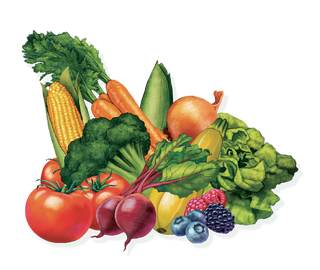How to plant strawberries, blueberries and other small fruits.
Follow the general planting directions in Easy Steps to Planting Nursery Stock.
Prune any crossed limbs or branches which rub against each other. This lets light into the center of the plant and becomes more important with each successive season as plants get bigger and bushier. Work the soil well so that the plants' roots aren't restricted. Avoid crowding--berry bushes need lots of room because they're heavy feeders, and the brambles put out numerous suckers. Place small fruits away from fruit and shade trees which might need spraying when the berries are ripening.
BLACKBERRIES -- All brambles require deep, well-drained loam soil high in organic matter. They can't tolerate sandy soil or soil that's so heavy it leaves moisture standing around the roots. Apply a balanced fertilizer at a rate of 10 pounds per 1,000 square feet. Cut plants back to 6 inches and place them in the hole at the same depth they grew in the nursery row. Space blackberries 5-6 feet apart in rows 8-10 feet apart and provide a trellis for trailing types. Canes can be woven or tied to keep them in place. Do not allow canes to set fruit the first year. Water heavily and mulch to reduce weeds. Thick layers of shredded bark, leaves, wood chips and hay make excellent mulches for any type of berry. Sawdust does not, however, because it packs too tightly and can deplete nitrogen from the soil as it rots.
BLUEBERRIES -- Blueberries must be planted where they have full sun most of the day and acidic soil (a pH of 4.5 to 5.5) that's well drained, porous and high in organic matter. The plants have shallow root systems and must be irrigated. A heavy mulch will help retain soil moisture and keep the roots cool. Prune off half of the top growth and space plants 4-5 feet apart in rows 8-10 feet apart. Incorporate plenty of organic matter in and around the planting holes and set plants at the same depth they grew in the nursery row. Control weeds with mulch instead of cultivation. In cold climates, blueberries benefit from a thick layer of mulch during the winter. Prune for fewer but larger berries by removing old branches; fruit is produced on year-old wood.
BOYSENBERRIES -- Set plants 6 feet apart. Mulch with straw or compost. Culture is the same as for blackberries. Plants can be left to trail on the ground the first season. In the fall, after growth has stopped, prune back half of new growth. Cover with additional mulch just before the ground freezes. When vines begin to bud, build a 3-wire trellis with the top wire 5 feet high and the bottom wire 2 feet above the ground. Weave vines onto the trellis in a fan shape. Remove small canes and prune long ones to fit. Do not cultivate. Cut out old canes and destroy them after the harvest.
CRANBERRY -- Grow this ground cover-like plant in an environment similar to blueberries, spacing the plants 3 feet apart. While the plants do not need to be grown in a bog, they do prefer plentiful moisture. Cover the plants when frost threatens in the spring to prevent damage to flowers or fruits.
CURRANTS & GOOSEBERRIES -- These plants do best in rich soil that is cool and moist but has good drainage. Plant 5 feet apart in rows 8 feet apart in full sun where summers are mild and in a partially shaded location where summers are hot and dry. Trim stems back by 2/3 after planting. Prune in spring after flowering. Fruit is produced on older wood--in the fall, remove any wood more than 3 years old.
ELDERBERRIES -- Elderberries thrive in moist, heavy soil and do not tolerate drier conditions. Plant 7-20 feet apart in full sun. Plants grow 12-14 feet tall, and some pruning is necessary to maintain size and shape. Berries are produced on the end of the current season's growth.
GRAPES -- Grapes thrive in fertile, well-drained soil. Choose a site that offers protection from wind and late frost. If possible, run vines east-west to reduce shade cast by the trellis. Work in fair amounts of compost before planting but don't over fertilize. Set the plants 8 feet apart in rows 10 feet apart. For the first year, main stems should be allowed to grow unchecked and vines should be trained on a trellis using 2 support wires. Prune in winter when dormant but before the weather becomes too cold. Canes that have borne fruit should be pruned back sharply. Remove old canes coming from the main stem and leave 4 new canes (shoots that started to grow the previous spring). The new canes should be cut back to 6 or 8 inches and 3 or 4 buds. These buds, found at the joints, produce the new shoots that bear leaves and grapes the following summer. Four of these new shoots will be used to repeat the same fruiting and pruning process the following winter.
HARDY FIG -- This pest free plant does best in moist, well-drained soils and full sun. Space plants 10 feet apart. North of zone 7, plants may die back to the ground unless protected by mulch for the winter.
KIWI -- Plant in any well-drained soil, mulch to retain moisture and keep plants shaded during the hot part of the day until well established. This is a fruiting vine that requires support, like a trellis similar to one you'd use for grapes, only stronger. Endposts should be 4-6 inches in diameter and 6-8 feet tall, with strong wires stretched between them. Place a temporary stake the height of the trellis next to each plant. The first season's growth should be tied to this stake and allowed to grow to the top of the trellis. Remove suckers and all but 4 lateral branches cut back to 18 inches, directing the plant's energy toward a single trunk. After the vine reaches a top wire, cut it back 3-6 inches to just above a plump bud. This causes the central vine to split and grow into a Y shape. Train lateral growth to wires but don't allow the 2 new leaders to twine around the wire supports. Once established along the wires, remove the temporary stakes.
Once trained to a trellis, prune your kiwi regularly. In late winter or early spring, trim away 3-year-old branches (those that have finished a second year of fruiting) and any damaged or twisted wood. Keep fruiting laterals pruned to 12 buds. You should also prune where necessary to keep branches 2 feet above the ground. Hardy kiwi generally begin bearing 3-10 years after planting. The Issai and Arctic Beauty varieties bear within 4-7 years if properly pruned.
MULBERRIES -- Mulberries prefer a damp location in fertile, loam soil. Add a generous helping of organic matter to the site before planting and work it in well. Male and female flowers are produced on separate trees, so it is best to plant in groups of 3-5 to ensure proper pollination. Set plants 15 feet apart or 3 feet apart for a hedge. Water frequently the first few years, especially during fruit development. Mulberries grow 25-40 feet tall and bear 4-5 years after planting.
PAWPAW -- Plant pawpaws in a fertile, moist location where they will have plenty of room to grow; the trees can reach 30 feet in height. Pawpaws prefer partial shade but will tolerate full sun. Plant 2 or more for best pollination. Little maintenance is required. Simply water during dry spells and fertilize each spring. Prune suckers from the base of the tree as they develop. Harvest when fruit is soft and coppery-brown to almost black. The flesh will look and smell like that of a banana.
PERSIMMON -- These trees can grow to 30 feet or more, so be sure to give them lots of room. Plant in full sun, digging a deep hole so the taproot fits without curling. Fertilize and mulch each spring. Water during dry periods. Prune out suckers as they appear. Persimmons do not ripen until late in the fall. The crop is best harvested after a frost, when the fruit is softened and slightly creased.
Have another question? Return to the Customer Service Help page or send an e-mail directly to Customer Service

